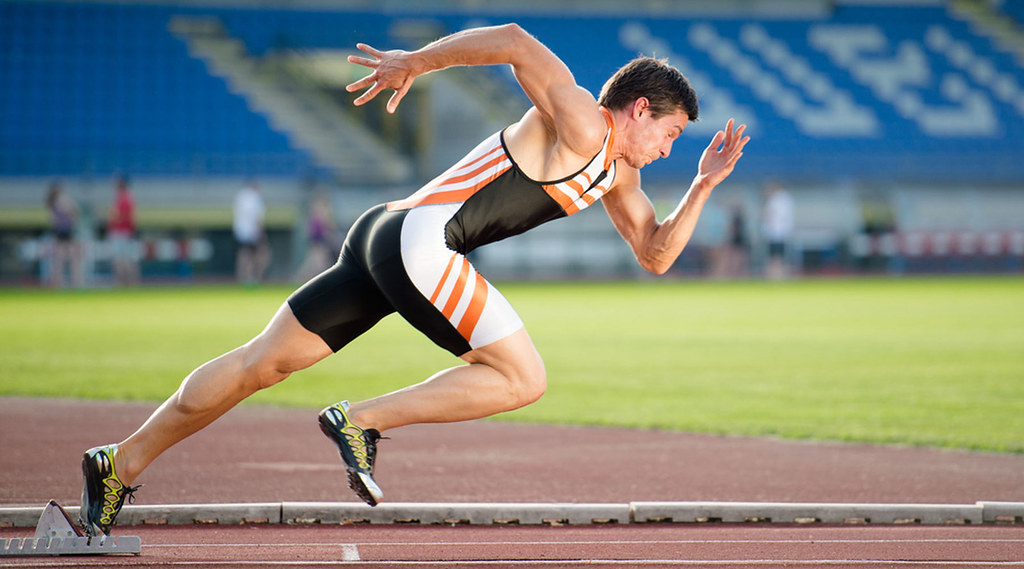
Integration of Whole Body Metabolism (The Living Cell)
Session Description: Integration of metabolism can be viewed at three levels; cell, organ and whole body. This session will explore how integration occurs and how it is regulated. At a cellular level apparently competing pathways can co-exist in the same cell but seldom take place at the same time. There are a number of different ways that both anabolic and catabolic pathways may be regulated within a cell which prevents futile cycling. These include separating the pathways into different subcellular compartments, reciprocal activation/deactivation through modification of key regulatory enzymes or perhaps changes in the level of expression of these enzymes. Some of these will be explored in this session. Learning objectives Describe the interaction between the liver and muscle during a sprint and a marathon Describe how with muscle and adipocytes, the liver can maintain blood glucose Outline the differences in the metabolism seen in mild and sever starvation Describe how the brain adapts to starvation
-
State some information about the brain in this context: (6)
• Brain- uses 100-120g glucose daily
• Over half the energy consumed is used for Na+-K+ transport to maintain membrane potential and the synthesis of neurotransmitters
• Lacks energy stores
• Glucose is transported by GLUT3 which has a low Km – saturated under most conditions
• Danger point when plasma glucose drops to below 2.2mM
• Normally fatty acids are used not for energy but for membrane biosynthesis
-
State some information about the Cardiac muscle in this context: (2)

-Is exclusively aerobic with little or no glycogen stores
-Fatty acids are the main source of energy followed by lactate and ketone bodies
-
State some information about the adipose tissue in this context: (4)
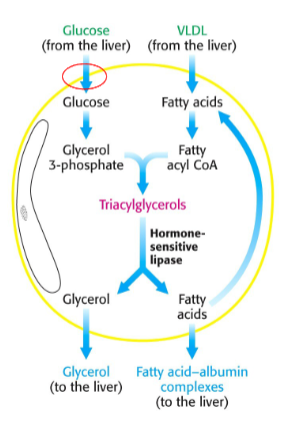
• Reservoir metabolic energy in the form of triglycerides• A 70kg man will have 15kg of TG• TG come either from the diet and delivered by chylomicrons• Synthesised by the liver and transportedby VLDL Glucose is transported by GLUT4 GLUT4 is insulin sensitive
-
State some information about the kidney in this context: (6)
• Major role is to produce urine• The plasma is filtered up 60 times daily• Only a small volume of urine is produced• Water soluble material largely reabsorbed toprevent loss• Although only 0.5% body mass theyconsume 10% of the energy• During starvation, the kidney may contribute halfof the blood glucose through gluconeogenesis
-
State some information about the liver in this context: (4)
• Plays a central role in regulating metabolism– Carbohydrate– Fatty acid– Amino acids• Most compounds absorbed by gut pass throughthe liver• Provides fuel for brain, muscle and otherperipheral organs• Takes its energy from α-ketoacids
-
State some information about the Control of Blood Glucose in this context: (2)
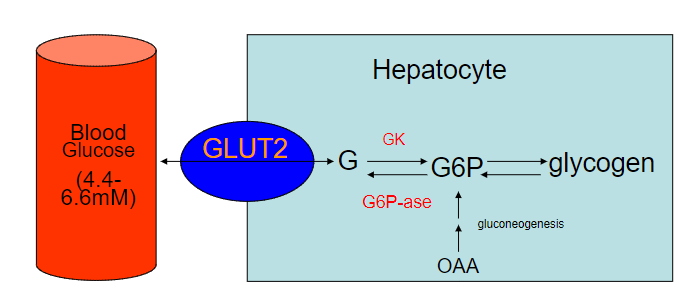
-Glucose is transported into hepatocytes by GLUT-2 (not insulin-sensitive) and immediatelyphosphorylated by glucokinase
-Glucose-6-phosphate from glycogen breakdown (or gluconeogenesis) is converted to glucose by the action of glucose-6 phosphatase and transported out of the cell and into the blood by Glut-2
-
State some information about the Muscle Glucose Metabolism in this context: (5)
![• Glucose uptake by Glut-4 is insulin-dependent• Glucose is converted into G6P by hexokinase (Km 0.1mM for glucose)• Low free [glucose] in cell• Glucose is mobilised from glycogen in exercise• Glycolysis of the G6P is a rapid source of ATP](/flashcards/cardimage2/b6ee8244/079/8079606_back.png)
• Glucose uptake by Glut-4 is insulin-dependent• Glucose is converted into G6P by hexokinase (Km 0.1mM for glucose)• Low free [glucose] in cell• Glucose is mobilised from glycogen in exercise• Glycolysis of the G6P is a rapid source of ATP
-
A picture outlining a Comparison of Hexokinase and Glucokinase Activities
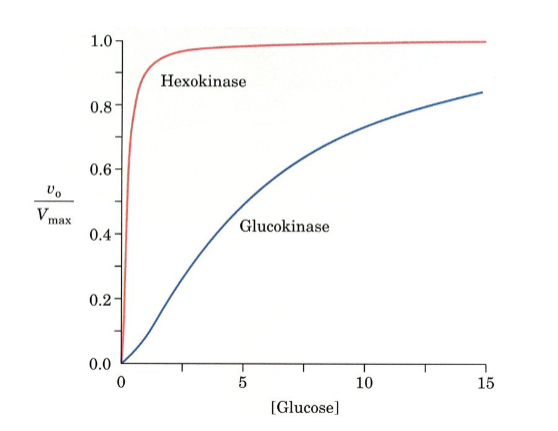
-
A picture outlining the Interchange of nutrients between organs
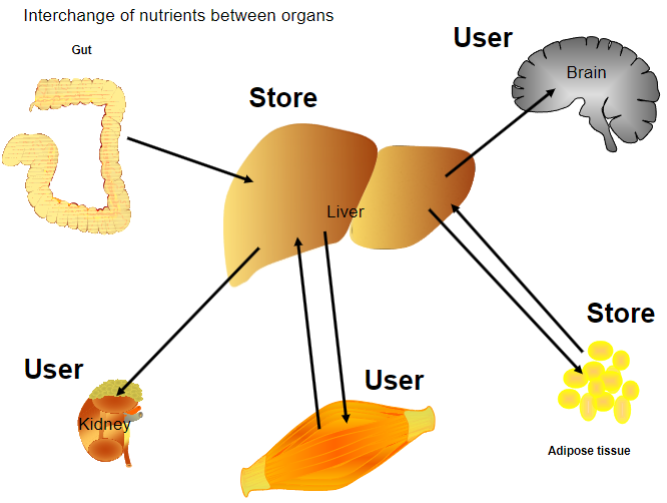
-
Outline the energy processes allowing for fuel for a sprint:
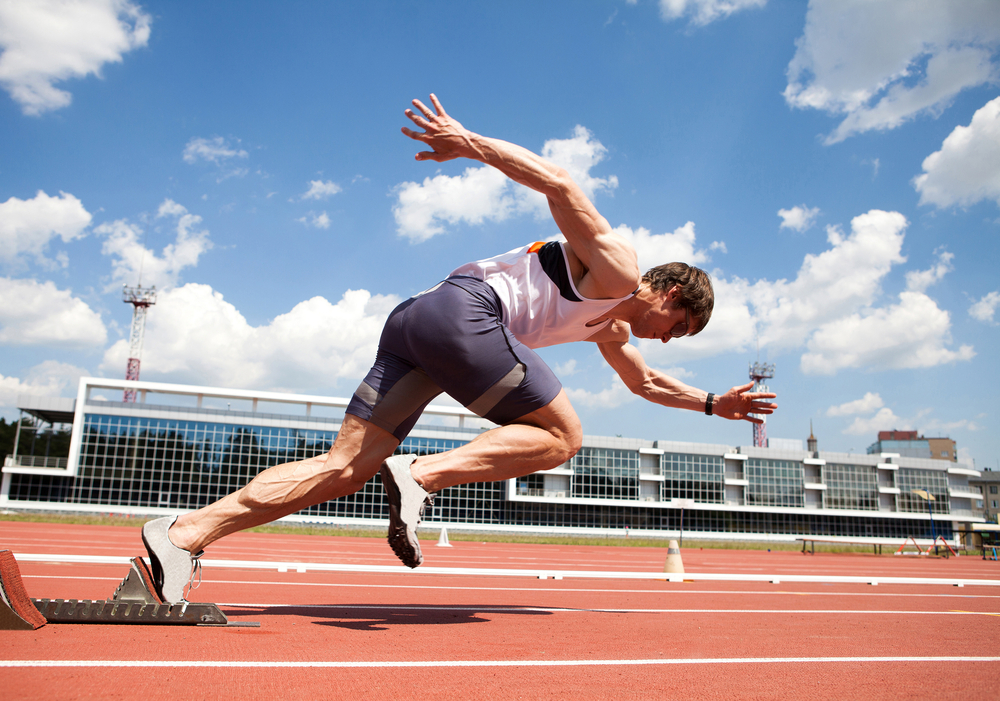
Rapid mobilisation of energy stores
• ATP directly powers musclecontraction• Power and speed is dependent onthe availability of ATP• Muscle ATP stores are small
Largely anaerobic
• ATP stores• Glycolysis• Glycogenolysis
-
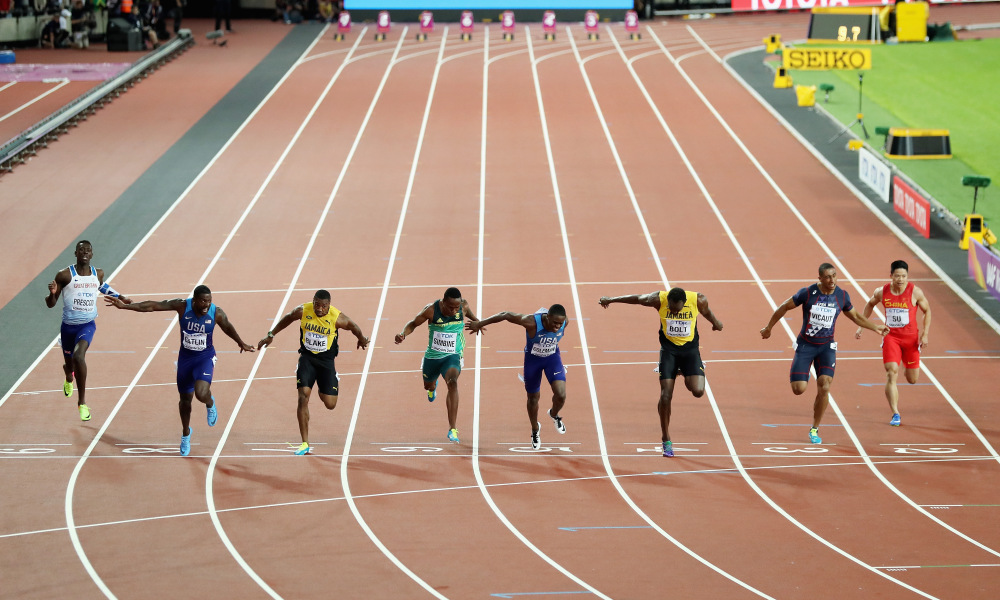
Outline the energy processes allowing for fuel for a 100m sprint powered by Creatine phosphate:

Relatively small but rapidly mobilised ATP storelasting only a few seconds
The build up of lactate and the fall in pH ultimatelylimits performance
-
Outline the energy processes allowing for fuel for a marathon:
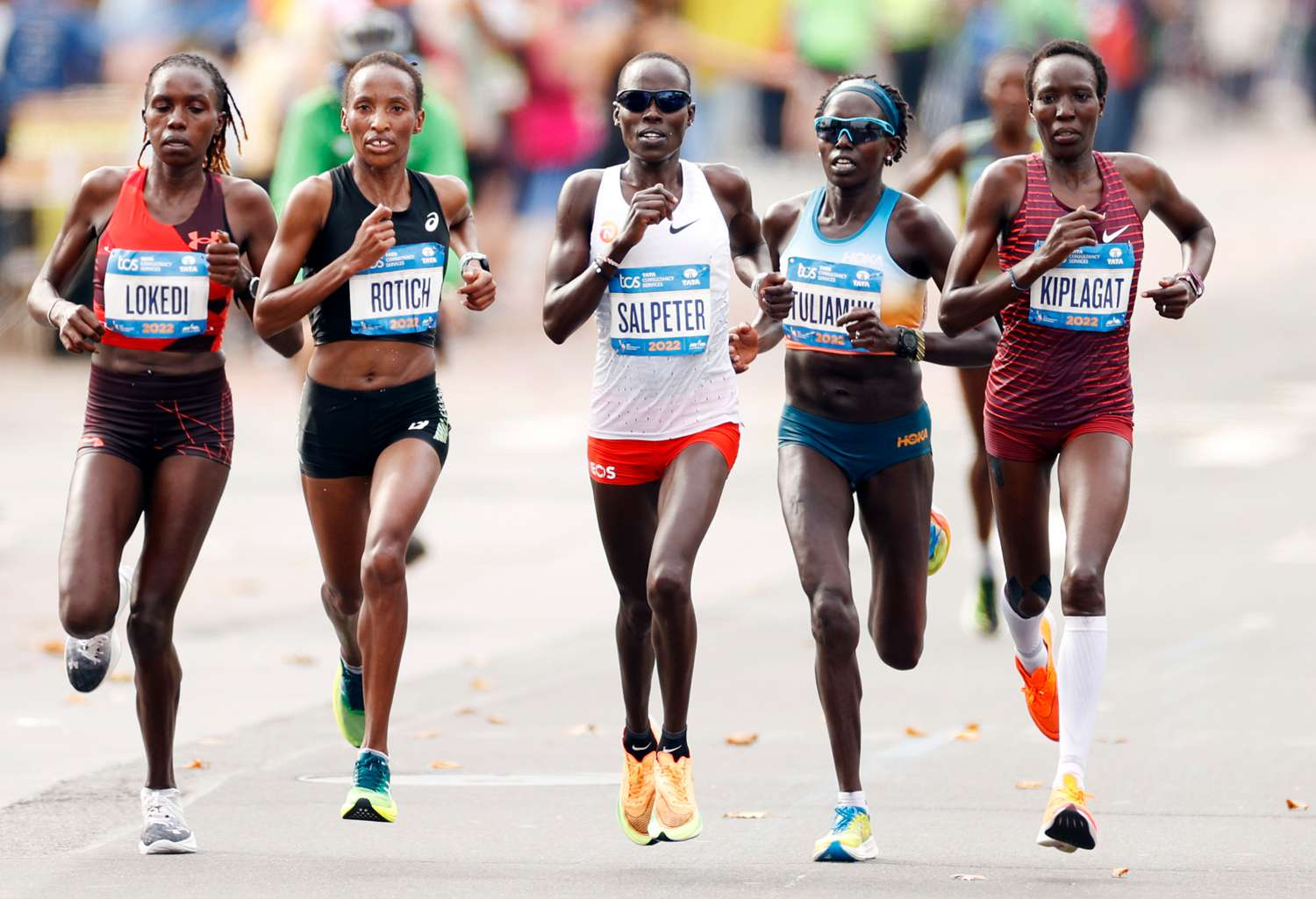
• Requires sustained energy provision• Uses aerobic respiration is more efficient• Requires co-operation of the muscle, liver and adipose tissue• Initially glycogen is used but later fat is mobilised from the adipose tissue.• Fats are a large source of ATP, butmetabolism is x10 slower than creatinephosphate• The combined use of both glycogen and fats is the efficient• The result is approximately half of theglycogen stores remain
-
Picture outlining the interaction between liver and muscle:
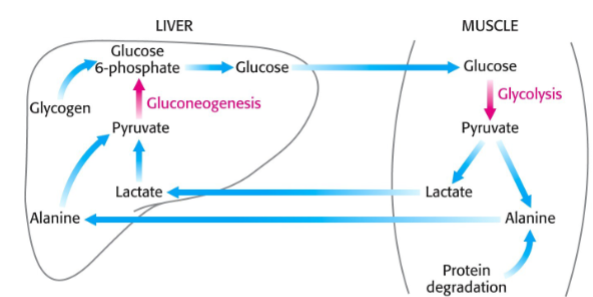
-
Picture outlining the Net flow of nutrients in the fed state
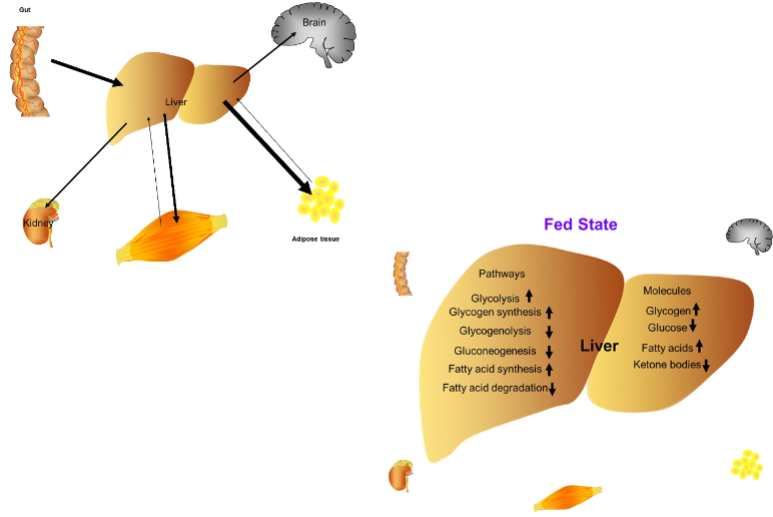
-
What are the priorities of the body when we stop eating? (2)
1st priority to maintain glucose levels2nd priority to preserve protein
To achieve this, metabolism shifts from glucose tofatty acids and ketone bodies
-
Outline what happens in the post absorptive phase (3)
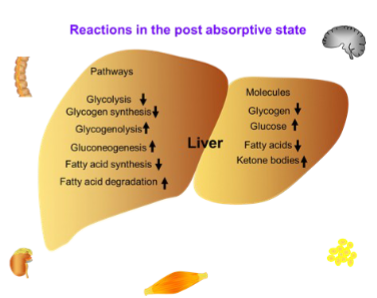
Several hours after the last meal
• blood glucose falls insulin levels fall and glucagon levels rise• phosphorylase a activity increases as does glycogen breakdown• drop in insulin reduces glucose uptake by muscle and adipose tissue
-
What happens during early starvation? (4)
• Glucose released from the liver due togluconeogenesis and glycogenolysis• Mobilisation of FA from adipose tissue• Glucose use falls as muscle switches toFA oxidation• Insulin drops causing GLUT4 expressionby muscle to fall reducing glucose uptakeAfter 12hrs 45% of resting energy from FAand 40% from glucose
Initial increase in protein break down
-
What happens during Intermediate starvation (3-20 days)? (6)
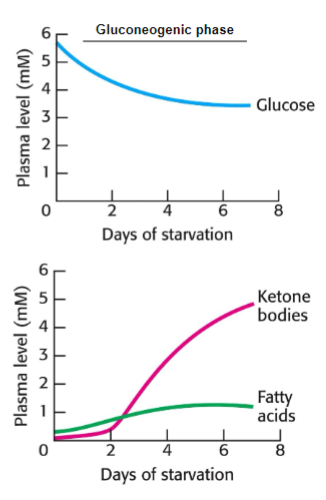
• Glycogen stores depleted• Increased lipolysis and ketogenesis• Increased gluconeogenesis to maintainblood glucose• 60hrs FA account for ¾ energy provision• After 8 days β-hydroxybutyrate is raised50 fold• Further starvation sees the kidney takeover gluconeogenesis from the liver
-
What happens during Prolonged starvation (> 3wks)? (6)
• β-hydroxybutyrate plateaux at 20 days• As brain starts to move to using ketone bodies the need for glucose falls from 100g to 40g/day• Other sources of gluconeogenic precursors are lactate and glycerol• Lactate is recycled by the Cori cycle• Glycerol and amino acids are oxidized• Proteins are broken down by the muscle forming amino acid precursors
-
A general summary:
• Different tissues have specific metabolic needs• Muscle source their energy depending on duration and severity of the exercise• Running a sprint requires rapid mobilisation of ATP stores at the expense of efficiency• Running a marathon requires the co-operation of multiple tissues• In the feed state metabolism is orientated towards storage of excess• In fasting organs work together to maintain blood glucose for the brain, kidney and erythrocytes• Long term metabolism shifts from glucose to fats and eventually proteins

